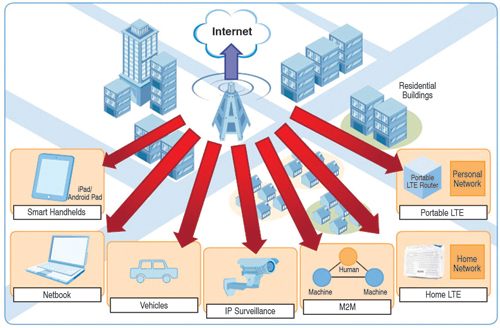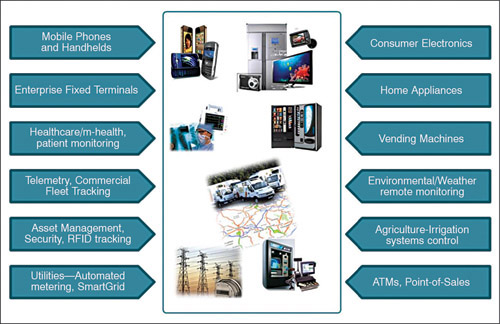The ‘things’ in the IoT, or the ‘machines’ in the M2M, are physical entities whose identity or state (or the state of whose surroundings) is capable of being relayed to an Internet-connected infrastructure. M2M refers to the machine-to-machine devices which span over a wide variety of telematics (where the host device is portable or mobile) and telemetry (where the device is stationary) applications and services.

LTE and M2M applications
Long-term evolution (LTE) is the fastest growing standard in the history of telecom industry, and the latest-generation mobile network technology. The LTE advanced standard is an enhancement to the LTE and is also known as 4G LTE.
Although the typical data rates for M2M communication are lower than the data rates for which LTE has been designed, some specific M2M applications can be created or enhanced to take advantage of the available bandwidth.
Key features of LTE
LTE offers the following features over 2G and 3G networks for better communication between the devices:
High gross bandwidth. It provides a high bandwidth of up to 150 Mbps down and 50 Mbps up in today’s networks, which is sufficient to stream eight simultaneous HDTV channels at a time.
Efficient sharing. LTE allows efficient sharing of the gross bandwidth between large number of users, allowing cost-effective allocation of data to different requirements of devices. It enables simultaneous handling of low-bandwidth traffic.
Reduced operational expenditure (OPEX). LTE reduces the operational expenditure through a simplified network architecture and better spectral efficiency. Thus there is a high rate of information transfer over a given bandwidth at low expenditure.
Low latency. It guarantees a maximum latency of around 10 milliseconds, below the human perception, which supports a faster communication.
Benefits of LTE in M2M market
Longevity. The lifecycle of older cellular networks is unpredictable and the cost of upgrading can be extraordinarily high. LTE will support connected devices in the field for many years to come.
Potentially lowered service costs. LTE is much more spectrum efficient and less expensive to operate than the previous-generation technologies.
Scalability. Most LTE networks deployed today support IPv6, making them well suited to mass M2M deployments which older networks are not able to support.
Superior performance. For M2M applications that require higher speeds and better responsiveness, LTE is an ideal solution.

Overcoming barriers to LTE adoption
Barriers for LTE adoption to M2M applications include a heavy hardware price premium in the M2M sector that is price-sensitive, and band fragmentation that adds to the cost and complexity. LTE also provides a dynamic data coverage with high bandwidth for applications that are often mission specific and do not require more bandwidth.
The cost of LTE modules and devices will go down in time, as is the case with all new technologies. Lack of LTE coverage in some areas will also be resolved as LTE deployments proceed around the globe.
Enhancement of LTE for M2M
Engineers are developing a new LTE broadcasting scheme that would allow the network to prevent all low-priority devices from accessing the network during certain time frames. Standard groups are working with LTE technology developers to create standards to protect the network from congestion or failures from roaming connections. This would be important for assuring that if there are multiple networks located in a single location, a failure in one network would not immediately lead to a huge spike in traffic (and potentially even a failure) in the other.
Optimising LTE for M2M
Following options can be considered to optimise LTE for M2M:
1. Developing a new class of low-cost, low-speed LTE devices
2. Reducing congestion caused by large-scale M2M deployments
3. Minimising the footprint of LTE devices accessing the network
4. Improving power efficiency with longer sleep cycles for latency-tolerant applications and configurable mobility-management functions
The high-speed and performance-based M2M applications are rapidly supporting LTE whilst others would soon converge their paths. The advantages of LTE are simply too great for M2M stakeholders to ignore for the IoT.
The author is a technical journalist at EFY, Gurgaon. (Key inputs from the ‘LTE—Delivering on the mobile broadband promise’ white paper by Charles Sturman, product manager-LTE-Chips, u-blox, Ezra Stein, product manager-LTE-Modules, u-blox, and Carl Fenger, product communications manager, u-blox)





